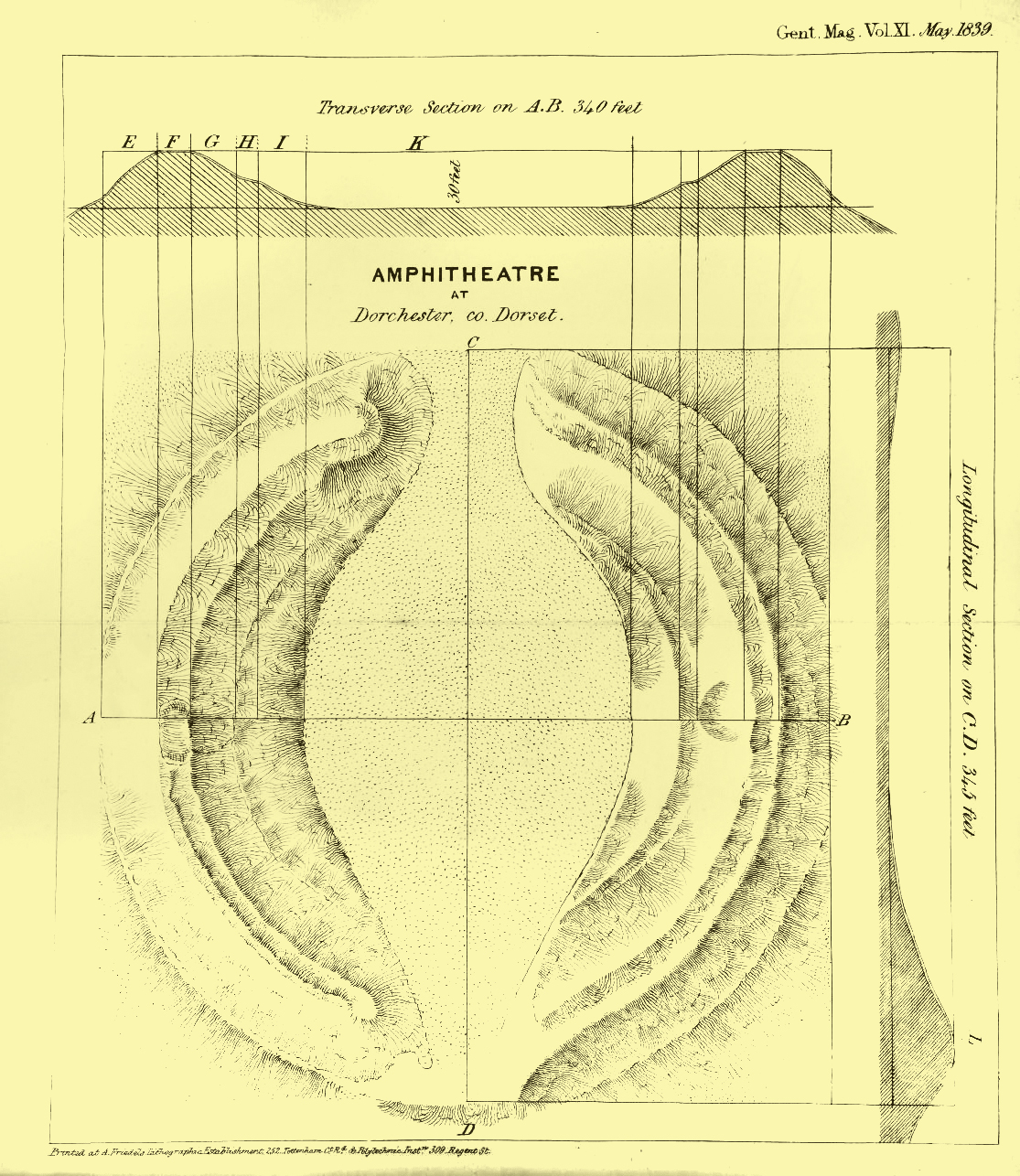The Roman Amphitheatre at Dorchester
William Barnes

On seeing the Roman Amphitheatre at Dorchester
By William Barnes (pub. Dorset County Chronicle 6 July 1826)
Circle of ages! undecaying mound!
Raised up by warlike Romans long ago, -
Where, many a time, the gladiatorial show
was seen by eager crowds that sat around.
Here the applausive "Euge" did resound
When nobler man had slain his bestial foe;
And groans were heard when, with the mortal blows,
They saw him prostrate, dying, on the ground.
O relict of that fair and might land.
From whose brave sons our fathers old not shield
The country and the homes they loved so well!
Long be it ere a hostile foreign land
Shall raise again a structure on this field
Where I long dwelt, and would forever dwell.
MR. URBAN, Dorchester, April 6.
I SEND you a plan and sections of the Amphitheatre at Dorchester. This monument of antiquity, which is in a better state of preservation than any other of the kind in England, is situated in a very large open arable field, called Fordington Field, about 500 yards close by the Weymouth Road, which runs on one of the Roman roads to Ridgway Hill, three miles and a quarter from the town, and is, so far, perfectly straight.
It was first observed as an Amphitheatre by Sir Christopher Wren, in going to Portland for stone, while building St. Paul's Cathedral; and was afterwards examined by Dr.
Stukeley, who read an account of it to a Society of Freemasons, at the Fountain in the Strand, in 1723; in which year he also printed that account, with a geometrical plan of the Amphi-theatre; and subsequently described it, and gave several views of it, in his Itinerarium Curiosum, Iter vi. pp. 155 - 168; and Hutchins, who surveyed it for his History of Dorset, gave a description and plate of it in that work.
Before the time of Sir C. Wren, it was always called, as the common people call it now, Mambury or Mamebury Ring. Mamebury being derived, in the opinion of some writers, from Malm (or Mame as it is called in the Dorset dialects), a kind of earthy chalk of which it consists, and Bury, taken in its common sense of an earthwork, as in Poundbury (near us), Woodbury, and Cadbury.*
Others again-and among them the acute author of the History of Dorchester, from whom I am sorry to differ-think its name is properly Maenbury, from the British maen a stone, and barri to divide, as it consists of two opposite parts; though I do not see, after allowing that its name should be British rather than Saxon or English, why it should have it from stone, as there is no stone on it or about it.
Stukeley in his geometrical plan makes it a rather eccentric ellipse; but, from the dimensions given by my chain (and they very nearly coincide with those found by Hutchins), and from the circular curve which I got by ordinates drawn to its base from a tangent, I think it was originally almost or quite a circle, on a diameter of about 350 feet; though, from the unequal inroads of the plough at different parts, its long external diameter is now about 345 feet, and its shorter one about 5 feet less. Stukeley says it is computed to consist of about an acre of ground; which is neither the area his own diameters would give, nor its true one; as the external circumference comprehends about 2 acres.
The part marked E in the section (see transverse section and plan) is the outward slope of the mound; F a terrace about 12 feet broad, still backed at some places, as between A and D, and on the opposite side of the Amphitheatre, by a parapet; G the upper inward slope, originally occupied by seats reaching down to H, which is a walk about 8 feet broad, called by Stukeley the iter circulare, and rising from the ends, affording to the spectators access to the seats at the slopes G and I, and also to the terrace on the top by the steps in the middle opposite A and B, an ascent, of which the place is still marked by inequalities of the ground the lower slope for seats. Under L, from which there is a gentle descent into the arena, was the caves for the animals, and at C was the great entrance.
Stukeley computed that the Amphitheatre would contain more than 12,000 spectators; which is not unlikely, as there were supposed to be 10,000 people within its external circumference at the execution of a Mrs. Mary Channing, the wife of a grocer of Dorchester, who was first strangled and then burnt in the arena for poisoning her husband, the 21st of March 1705. A spectator standing on the terrace has within sight the great earthwork Maiden Castle, the site of the capital of the Durotriges; Poundbury, which the author of the History of Dorchester considers to have been a British Field of Council; and innumerable barrows on the summits of hills to the south and south-west.
Yours, &c. W. BARNES.
The Gentlemans Magazine, May 1839
*Ingram, in his general rules for the investigation of the names of places appended to the Saxon Chronicle, defines the Saxon words from which we derive Bury, as a place of retreat; and thence Bury in the names of many places originated from an earthwork, or a monastery, which were both places of retreat.


